fuel type Citroen C4 CACTUS 2016 1.G Owner's Manual
[x] Cancel search | Manufacturer: CITROEN, Model Year: 2016, Model line: C4 CACTUS, Model: Citroen C4 CACTUS 2016 1.GPages: 308, PDF Size: 7.96 MB
Page 135 of 308

133
Stop & Start
Operation
Going into engine STOP
mode
The "ECO" warning lamp comes on i
n the instrument panel and the engine g
oes into standby automatically:
-
w
ith a manual gearbox , when stationary,
in
neutral, and you release the clutch
ped
al.
-
w
ith an electronic gearbox , when
stationary
or at speeds below 5 mph
(
8 km/h) (depending on version), in neutral
(
control on N )
or when you press the brake
ped
al. Never
refuel with the engine in STOP
m
ode; you must switch off the ignition.
For
your comfort, during parking
m
anoeuvres, STOP mode is not
a
vailable for a few seconds after
c
oming out of reverse gear.
The
Stop & Start system does not affect
t
he the vehicle's other systems, such as
f
or example braking, power steering...
The
Stop
&
Start system
puts
the
engine
t
emporarily
into
standby
-
STOP
mode
-
during
s
tops
in
the
traffic
(red
lights,
traffic
jams,
or
o
ther...).
The
engine
restarts
automatically
-
S
TART
mode
-
as
soon
as
you
want
to
move
o
ff.
The
restart
takes
place
instantly,
quickly
a
nd
silently.
Per fect
for
urban
use,
the
Stop
&
Start
system
r
educes
fuel
consumption
and
exhaust
e
missions
as
well
as
the
noise
level
when
s
tationary.
Stop & Start time
counter
A cumulative time counter for periods i n STOP mode during a journey.
It
is
displayed in the trip computer (accessible
v
ia the " Driving assistance "
menu of the
t
ouch
screen tablet).
It
resets
to zero every time the ignition is
s
witched
on.
The
Stop
&
Start
system
requires
t
he
use
of
a
12
V
battery
of
special
t
echnology
and
specification.
All
w
ork
on
this
type
of
battery
must
o
nly
be
done
by
a
CITROËN
dealer
o
r
a
qualified
workshop.
For
more
i
nformation
on
the
12
V
battery,
refer
to
t
he
corresponding
section.
6
Driving
Page 156 of 308
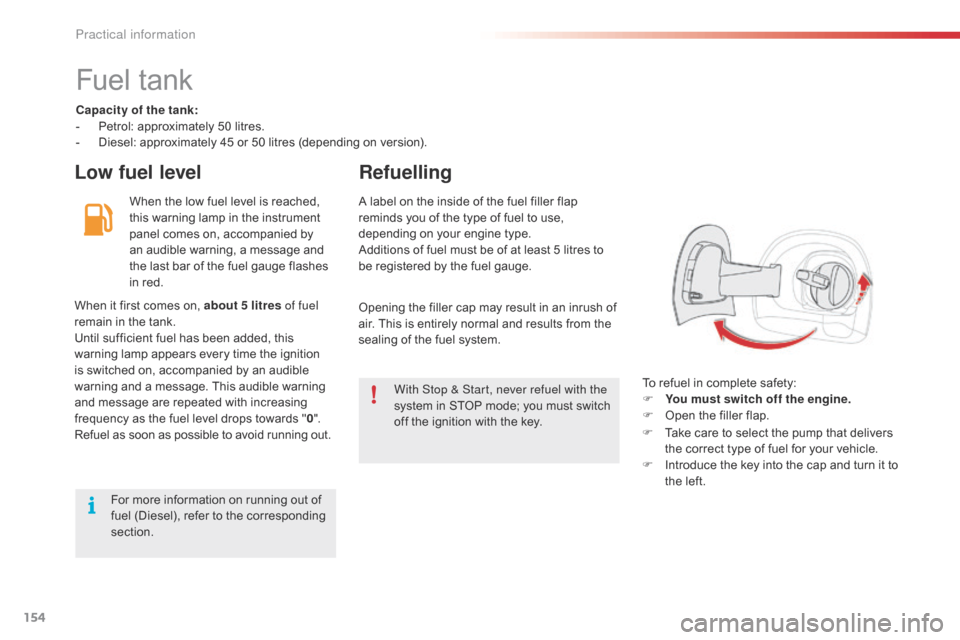
154
Fuel tank
Capacity of the tank:
- Pe trol: approximately 50 litres.
-
D
iesel: approximately 45 or 50 litres (depending on version).
Low fuel levelRefuelling
When the low fuel level is reached, t
his warning lamp in the instrument
p
anel comes on, accompanied by
a
n audible warning, a message and
t
he last bar of the fuel gauge flashes
i
n red.
To
refuel in complete safety:
F
Y
ou must switch off the engine.
F
O
pen the filler flap.
A
label on the inside of the fuel filler flap r
eminds you of the type of fuel to use,
d
epending on your engine type.
Additions
of fuel must be of at least 5 litres to
b
e registered by the fuel gauge.
When
it
first comes on, about 5 litres of fuel
remain
in
the tank.
Until
sufficient fuel has been added, this
w
arning
lamp appears every time the ignition
i
s
switched on, accompanied by an audible
w
arning
and a message. This audible warning
a
nd
message are repeated with increasing
f
requency
as the fuel level drops towards "0 ".
Refuel
as
soon as possible to avoid running out.Opening
the filler cap may result in an inrush of
a
ir. This is entirely normal and results from the
s
ealing of the fuel system.
With Stop & Start, never refuel with the
system
in STOP mode; you must switch
o
ff the ignition with the key.
For
more information on running out of
f
uel (Diesel), refer to the corresponding
s
ection. F
T
ake care to select the pump that delivers
t
he correct type of fuel for your vehicle.
F
I
ntroduce the key into the cap and turn it to
t
he left.
Practical information
Page 158 of 308
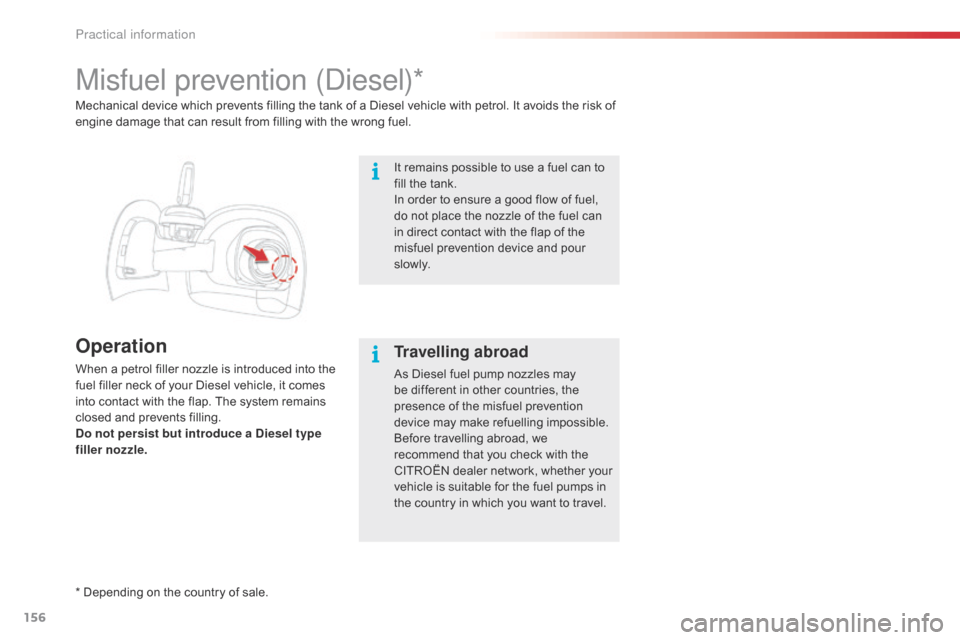
156
Misfuel prevention (Diesel)*
Operation
When a petrol filler nozzle is introduced into the fuel filler neck of your Diesel vehicle, it comes
i
nto contact with the flap. The system remains
c
losed and prevents filling.
Do not persist but introduce a Diesel type
filler nozzle.
*
Depending on the country of sale.
Mechanical
device which prevents filling the tank of a Diesel vehicle with petrol. It avoids the risk of
e
ngine damage that can result from filling with the wrong fuel.
It remains possible to use a fuel can to
f
ill the tank.
In order to ensure a good flow of fuel,
d
o not place the nozzle of the fuel can
i
n direct contact with the flap of the
m
isfuel prevention device and pour
s
l ow l y.Travelling abroad
As Diesel fuel pump nozzles may b
e different in other countries, the
p
resence of the misfuel prevention
d
evice may make refuelling impossible.
Before
travelling abroad, we
r
ecommend that you check with the
C
ITROËN dealer network, whether your
v
ehicle is suitable for the fuel pumps in
t
he country in which you want to travel.
Practical information
Page 159 of 308
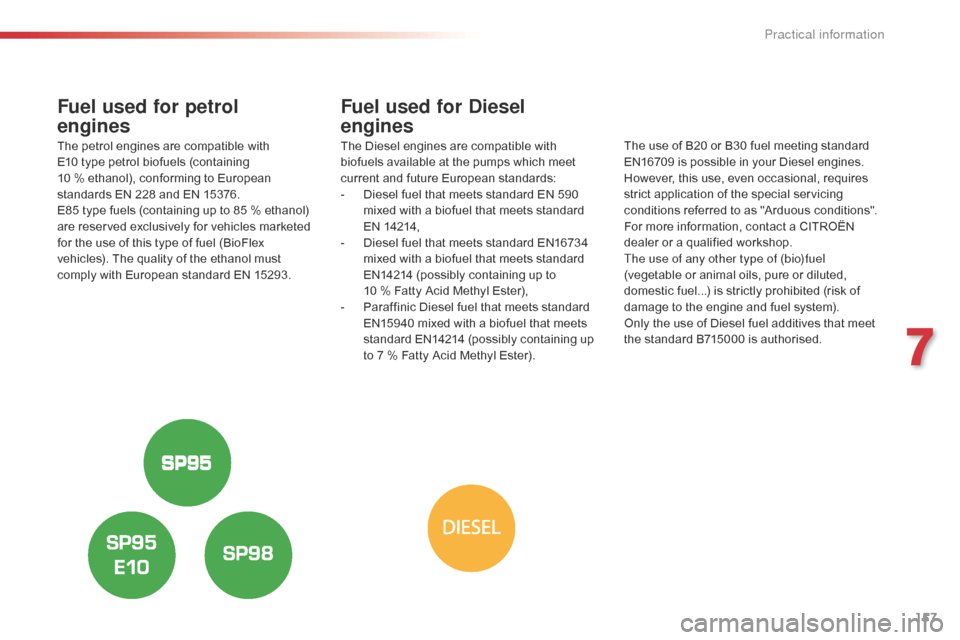
157
Fuel used for petrol
engines
The petrol engines are compatible with E
10 type petrol biofuels (containing
1
0 % ethanol), conforming to European
s
tandards EN 228 and EN 15376.
E85
type fuels (containing up to 85 % ethanol)
a
re reserved exclusively for vehicles marketed
f
or the use of this type of fuel (BioFlex
v
ehicles). The quality of the ethanol must
c
omply with European standard EN 15293.
Fuel used for Diesel
engines
The Diesel engines are compatible with biofuels available at the pumps which meet
c
urrent and future European standards:
-
D
iesel fuel that meets standard EN 590
m
ixed with a biofuel that meets standard
E
N
14
214,
-
D
iesel fuel that meets standard EN16734
m
ixed with a biofuel that meets standard
E
N14214 (possibly containing up to
1
0 % Fatty Acid Methyl Ester),
-
P
araffinic Diesel fuel that meets standard
E
N15940 mixed with a biofuel that meets
s
tandard EN14214 (possibly containing up
t
o 7 % Fatty Acid Methyl Ester).The
use of B20 or B30 fuel meeting standard E
N16709 is possible in your Diesel engines.
H
owever, this use, even occasional, requires
s
trict application of the special servicing
c
onditions referred to as "Arduous conditions".
F
or more information, contact a CITROËN
d
ealer or a qualified workshop.
The use of any other type of (bio)fuel
(vegetable
or animal oils, pure or diluted,
d
omestic fuel...) is strictly prohibited (risk of
d
amage to the engine and fuel system).
Only
the use of Diesel fuel additives that meet
t
he standard B715000 is authorised.
7
Practical information
Page 222 of 308

220
EnginePureTech 75PureTech 82PureTech 82 S&S PureTech 110 S&S
Gearbox Manual
(5-speed) Manual
(5-speed) ETG electronic
(5-speed) Manual
(5-speed)
Model code 0PHMU0PHMZ0PHNZ
Cubic capacity (cc) 1
1991
1991
199
Bore
x stroke (mm) 75
x 90.575
x 90.575
x 90.5
Max
power: EU standard (kW)* 55 60 81
Max
power engine speed (rpm) 5
7505
7505
500
Max
torque: EU standard (Nm) 11 6 118205
Max
torque engine speed (rpm) 2
7502
7501
500
Fuel UnleadedUnleadedUnleaded
Catalytic converter yesyesyes
Engine
oil capacity with replacement of the oil
f
ilter (in litres) 3.25
3.25 3.5
*
T
he maximum power corresponds to the type approved value on a test bed, under conditions defined by European legislation
(directive
1
999/99/EC).
Engines and gearboxes - PETROL
Technical data
Page 224 of 308
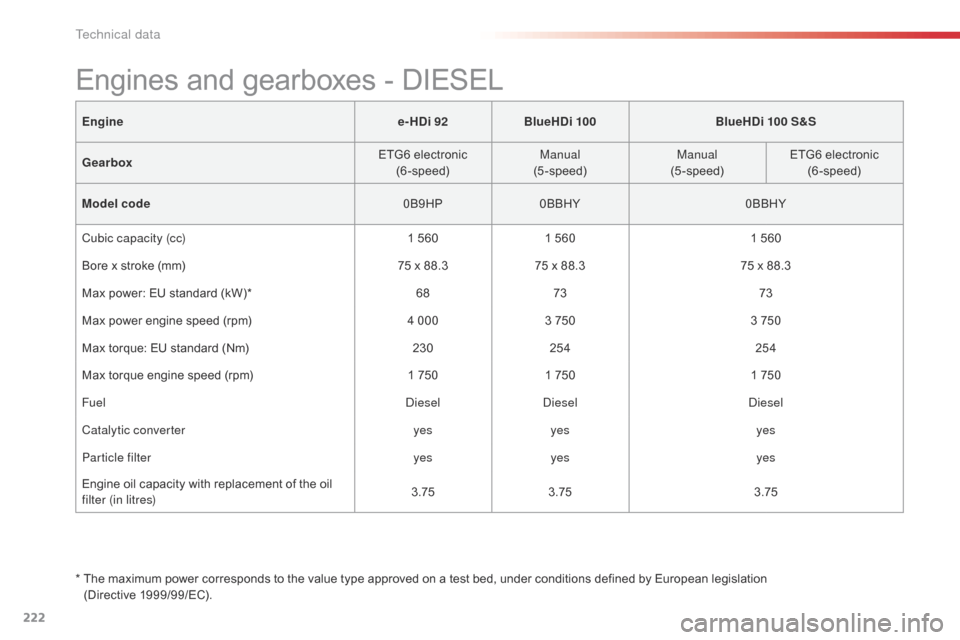
222
Enginee-HDi 92BlueHDi 100 BlueHDi 100 S&S
Gearbox ETG6
e
lectronic
(6-speed) Manual
(5-speed) Manual
(5-speed) ETG6
e
lectronic
(6-speed)
Model code 0B9HP0BBHY 0BBHY
Cubic capacity (cc) 1
5601
5601
560
Bore
x stroke (mm) 75
x 88.375
x 88.375
x 88.3
Max
power: EU standard (kW)* 6873 73
Max
power engine speed (rpm) 4
0003
7503
750
Max
torque: EU standard (Nm) 230254 254
Max
torque engine speed (rpm) 1
7501
7501
750
Fuel DieselDiesel Diesel
Catalytic converter yesyes yes
Particle filter yesyes yes
Engine
oil capacity with replacement of the oil
f
ilter (in litres) 3.75
3.75 3.75
*
T
he maximum power corresponds to the value type approved on a test bed, under conditions defined by European legislation
(Directive
1
999/99/EC).
Engines and gearboxes - DIESEL
Technical data
Page 227 of 308
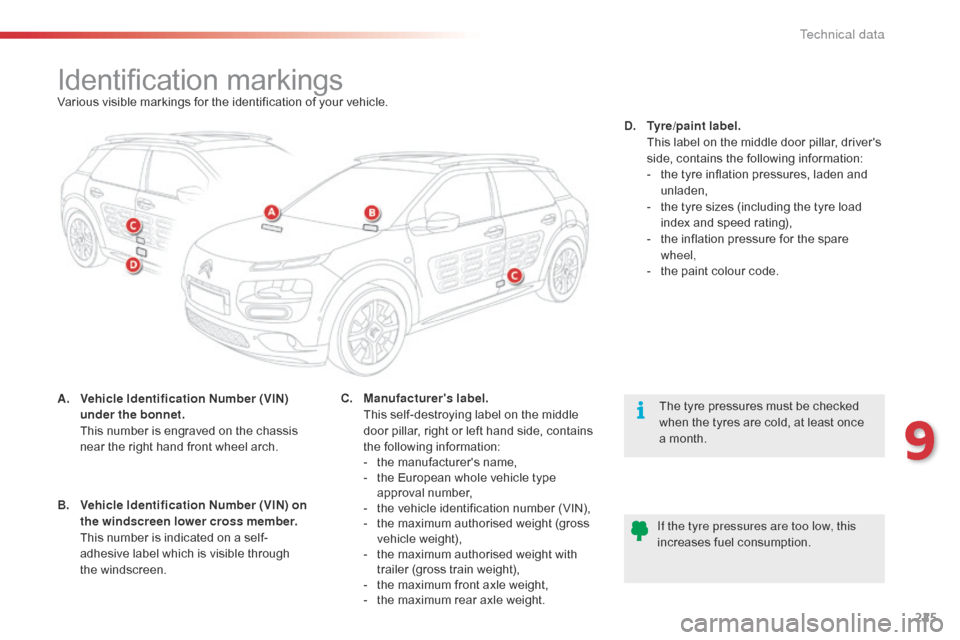
225
Identification markingsVarious visible markings for the identification of your vehicle.
A.
V
ehicle Identification Number (VIN)
under the bonnet.
T
his number is engraved on the chassis
n
ear the right hand front wheel arch. The
tyre pressures must be checked
w
hen the tyres are cold, at least once
a
month.
If the tyre pressures are too low, this
increases
fuel consumption.
C.
M
anufacturer's label.
T
his self-destroying label on the middle
d
oor pillar, right or left hand side, contains
th
e
f
ollowing
i
nformation:
-
t
he manufacturer's name,
-
t
he European whole vehicle type
a
pproval number,
-
t
he vehicle identification number (VIN),
-
t
he maximum authorised weight (gross
ve
hicle
w
eight),
-
t
he maximum authorised weight with
t
railer (gross train weight),
-
t
he maximum front axle weight,
-
t
he maximum rear axle weight.D.
T
yre/paint label.
T
his label on the middle door pillar, driver's
s
ide, contains the following information:
-
t
he tyre inflation pressures, laden and
u
nladen,
-
t
he tyre sizes (including the tyre load
i
ndex and speed rating),
-
t
he inflation pressure for the spare
w
heel,
-
t
he paint colour code.
B.
V
ehicle Identification Number (VIN) on
the windscreen lower cross member.
T
his number is indicated on a self-
adhesive
label which is visible through
t
he windscreen.
9
Technical data